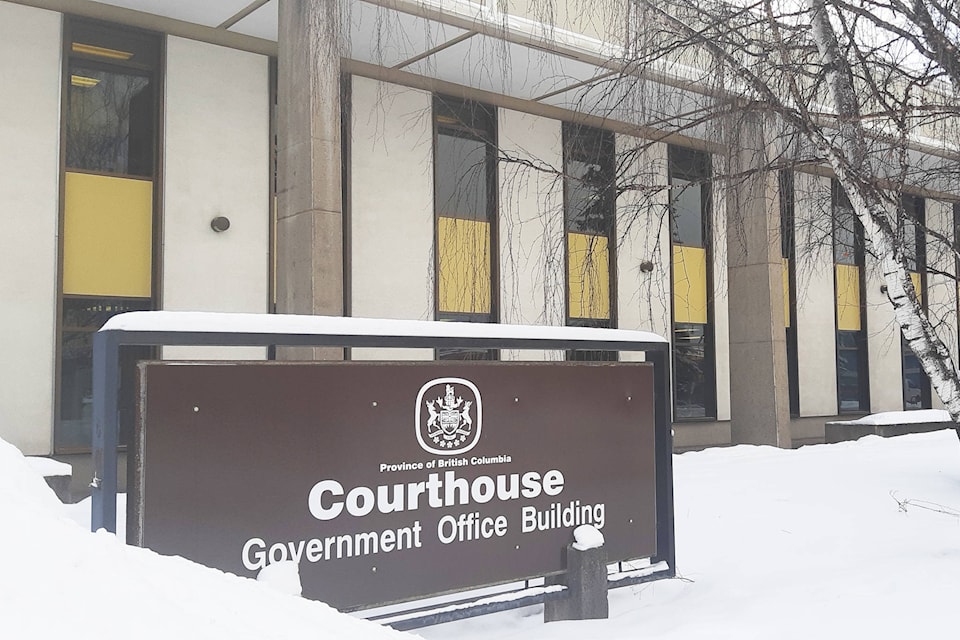The fate of a Burns Lake man accused of killing his ex-wife’s alleged new romantic interest is now in the hands of a judge.
This week Crown and defence presented their closing summations in the murder trial of Albert Giesbrecht to Justice David Crossin at the B.C. Supreme Court in Smithers.
Before proceeding with the Crown’s case Monday, prosecutor Sandy MacDonell withdrew the charge of first degree murder saying he would be arguing for second degree murder, as well as the lesser-included charge of manslaughter.
The Crown alleges that on the morning of May 18, 2017, still angry about his 2015 divorce from Susan Giesbrecht and jealous of a perceived relationship between Susan and the victim, Raymond Bishop, Albert went looking for them with the intent to criminally harass them.
Not in dispute is that Albert jumped into his pickup truck that morning with his dog and two loaded rifles, a 30-30 and a .22, then took the ferry from Burns Lake to Southside. Near the ferry terminal Albert and Bishop encountered each other.
Video evidence from the terminal shows Bishop’s vehicle following Albert’s until they are both out of view. Within the next couple of minutes Bishop was dead from a single gunshot wound to the chest discharged from Albert’s 30-30 at close range— an expert witness estimated eight inches.
READ MORE: Third week of Giesbrecht murder trial wraps up
READ MORE: Trial continues
During the trial the Crown painted a picture of decades of domestic abuse leading up to the Giesbrecht couple’s separation and eventual divorce.
MacDonell presented witnesses and corroborating phone calls, emails and text messages indicating Albert was still upset about the situation and that his behaviour represented a pattern of harassment from which intent to harm Susan and/or Bishop could be inferred.
Terry La Liberte, Albert’s attorney, maintained it was Bishop who was the aggressor that morning, following Albert then pulling around him and cutting him off. According to the defence, Bishop then got out of the truck and attacked Albert with a kick to the ankle, which made Albert go down and the gun accidentally discharge.
The Crown said the trajectory of the bullet was not consistent with that explanation and pointed to Albert’s behaviour after the shooting as evidence that the only reasonable theory of what transpired is murder.
The defendant called 911 very shortly after the shooting and reported he had just shot someone. In the exchange with the operator he initially said he didn’t know who it was who was following him, but thought his name was Ray Bishop.
When the operator asked if he shot Bishop because he was following him, he said yes, but admitted it went deeper than that. When asked about the history between them, Albert said he thought Bishop was “screwing [his] ex-wife.”
MacDonell said during the initial call there was plenty of opportunity for Albert to explain it was an accident, but that explanation did not come up until a second 911 call nearly two hours later.
The defence insisted there were many alternative explanations for both the shooting and the 911 call that were just as reasonable under the circumstances of an innocent man finding himself being followed and attacked.
La Liberte said prosecutors had failed to prove beyond a reasonable doubt that their version was the only reasonable theory for what occurred.
Following almost five full days of closing arguments, the trial ended Friday afternoon.
Justice Crossin thanked the lawyers for an orderly and professional trial and scheduled April 8 to fix a date for his verdict.
For the full story, see the April 3, 2019 edition of The Interior News.
editor@interior-news.com
Like us on Facebook and follow us on Twitter
